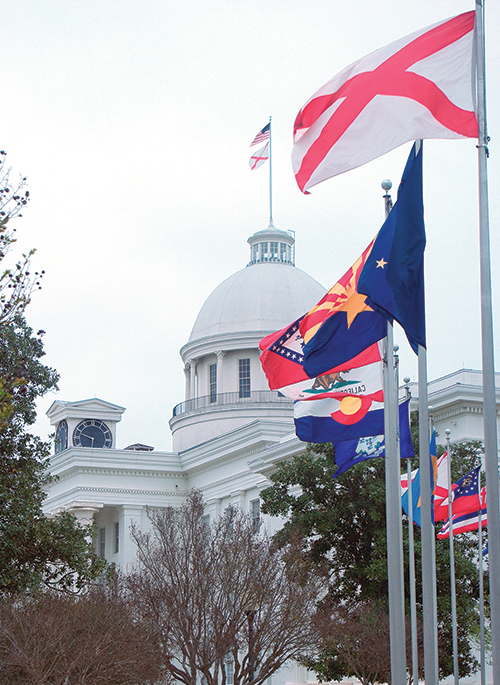Budgeting battle for state agencies begins again
By Minnie Lamberth
Alabama legislators will have serious work ahead as they iron out financial details for the General Fund, the budget that supports the state’s non-education agencies. Last year around this time, they were facing a projected $256 million deficit for these services, and their laborious efforts to pass the budget extended past the regular session and into two special sessions before receiving the governor’s signature on a funding bill for the fiscal year that began Oct. 1.
 In the process, legislators came up with some additional funding and a number of reductions. “We ended up passing about $165 million in recurring revenues,” says Rep. Steve Clouse, R-Ozark, chair of the House Ways and Means General Fund Committee. These revenues included a 25-cent increase in the cigarette tax and an increase in pharmacy and nursing home provider fees. Legislators also moved about $80 million in use tax from the Education Trust Fund to the General Fund. “We still ended up cutting $82 million from the previous year,” Clouse says.
In the process, legislators came up with some additional funding and a number of reductions. “We ended up passing about $165 million in recurring revenues,” says Rep. Steve Clouse, R-Ozark, chair of the House Ways and Means General Fund Committee. These revenues included a 25-cent increase in the cigarette tax and an increase in pharmacy and nursing home provider fees. Legislators also moved about $80 million in use tax from the Education Trust Fund to the General Fund. “We still ended up cutting $82 million from the previous year,” Clouse says.
In the final budget that’s in place for the current fiscal year, some of the larger agencies, such as the Medicaid agency, prison system and mental health department, were level funded, though others saw a range of cuts. “Most agencies were cut in excess of 5%,” says Sen. Arthur Orr, R-Decatur, chair of the Senate Finance and Taxation General Fund Committee.
Now, as legislators convene on Feb. 2 for the 2016 Regular Session, they’re back to the same task.
“Preliminarily it looks like it’s going to be another difficult year for the General Fund,” Orr says. “The revenues are flat. The demands are greater.”
The state’s Medicaid Agency and the Department of Corrections in particular both need additional funding. Orr says Medicaid alone needs more than a $100 million increase. The state’s transition to a risk-bearing model where regional care organizations deliver Medicaid services for a fixed amount is responsible for much of this need.
“Then you’ve got the correctional system. They’ve got to receive an increase,” Orr says. “Facilities are outdated and in dire shape for the Department of Corrections.” According to Orr, the prisons are currently at 190% capacity, which is one of the highest levels in the nation.
Medicaid and Corrections “are the two largest agencies as far as receiving discretionary dollars,” Orr says. Those discretionary dollars make up a fairly small part of the pie.
Earmarked taxes limit the Legislature’s ability to move funds from one need to another. Though the General Fund budget could total $10-$12 billion overall, Orr says, “We only have discretion over $1.8 billion, give or take.”
For example, gasoline taxes are earmarked for the Department of Transportation; liquor taxes are earmarked for the Department of Mental Health. “There’s not legislative discretion over where that money goes,” Orr says. “It’s already been preassigned what agency will receive those funds.”
Legislators take another factor into account. Orr points out that some agencies have a designated revenue stream, which makes them less dependent on appropriations from the General Fund. The Alabama Department of Environmental Management is an example. “They can raise their fees,” Orr says.
ADEM had previously received around $1 million of General Fund appropriation. “That was cut. Then they were getting regular permit fees. An additional $1 million of that money was transferred out,” Orr says.
For ADEM’s director, Lance LeFleur, these actions have caused concern. “Our department has been under the scrutiny of the EPA for lack of funding for some time,” LeFleur says. His agency’s state appropriation is now approximately zero. “We’ve just gone up on fees to industries to compensate for 2016 cuts,” he adds.
Given the department’s requirement to transfer out dedicated cleanup fees to the General Fund, he says, “We are a revenue source to the General Fund, which is a very sad state of affairs.”
Agency efficiency is another area where legislators will give attention. “Legislators are going to want to deep dive into these agencies,” Clouse says. “They’re going to have to justify all their expenses.” He already sees progress on that front. “We’re down 5,000 state employees than we were six years ago.”
Another issue will be to look at federal funding and what the state is required to provide to receive those funds. “We want to see how much federal money each agency gets and what state money is required to draw those dollars down,” Clouse says.
New taxes are unlikely. “As many fights as we had over raising revenue (last year), I think it’s pretty evident that there’s not going to be new revenue,” he says.




